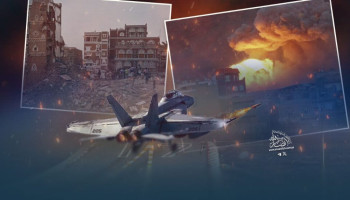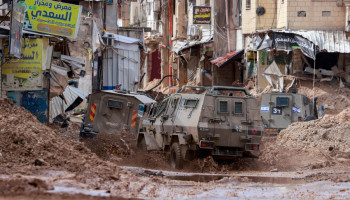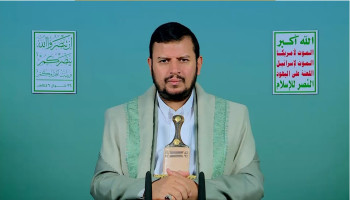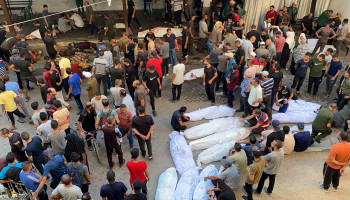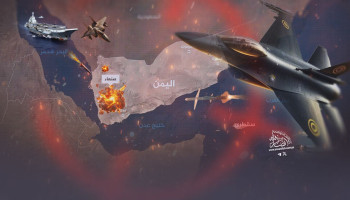An unholy union between Saudi-led Coalition and terrorism against Yemen
الاثنين, 27 أبريل 2020

Since 2015, when Saudi Arabia announced from Washington D.C. that it had launched a military campaign against the poorest country in the Middle East, it has been an open secret that both Saudi Arabia and the United Arab Emirates had formed an unholy union with al-Qaeda’s branch in Saudi Arabia and Yemen, known colloquially as AQAP, al-Qaeda in the Arabian Peninsula.
In al-Jawf, the relationship between Saudi Arabia and AQAP was well underway by 2016 when the Kingdom launched a military campaign to take the province. Saudi and AQAP forces fought side by side, sharing the same weapons, trenches, operations command centers, resting places, and extremist ideals. The only thing they didn’t share was a desire to destroy the United States, a trait exclusive to al-Qaeda according to documents left behind by fallen fighters and the confessions of Saudi soldiers captured in the battle for al-Jawf.
Abandoned ID cards and “official” documents feature the al-Qaeda logo
Abandoned ID cards and “official” documents feature the al-Qaeda logo
AQAP has hobbled by in Yemen for years, feeding off the relentless cycle of poverty and hunger and only occasionally emerging from the shadows to claim credit for an attack or seek new recruits. It was not until 2015 when the group began to receive support from Saudi Arabia that it become brazen enough to emerge from its hiding places into the streets of al-Jawf’s towns. Generous Saudi backing meant that AQAP could boost recruitment, build new training camps and promote the organization’s ideology, an offshoot of the official Saudi state religion of Wahhabism. By early 2020, AQAP had a sizable real estate portfolio in al-Jawf and Marib and ran most of the provinces’ large businesses. Sprawling villages in al-Jawf, the second largest governorate in Yemen, turned into strongholds of the organization after residents were forced to flee to other areas. AQAP turned some of the abandoned homes into factories used to manufacture explosive belts, IEDs and car bombs. Others were used to stock weapons, train fighters and prepare for their “global Jihad.”
The secret prison’s of Khazaf and al-Marwan
Finally, we reached two of al-Qaeda’s main strongholds in the far northeastern Khab and al-Shaf districts, near the edge of the expansive Rub’ al Khali Desert (the Empty Quarter). The villages of Khazaf and al-Marwan are little more than dried up oases scattered in the remote desert like the remains of some ancient colony. It was here that humble houses made from dried mud bricks were turned into factories, secret prisons, and centers for the dissemination of extremist Wahhabi propaganda.
Villagers here described bottle dungeons dug into the dirt floors of local houses. Accessible only via small overhead hatches, they were used by militants to keep prisoners, including captured female slaves, as well as dead bodies. Deep below two houses, we were shown complex tunnels systems ostensibly used to hold and torture prisoners. The stench of human death lingered in the dark tunnels mingling with the smell of dust and concrete. The tunnels were also used as corridors to move weapons and supplies from house to house undetected.
Inside one home that turned it into a makeshift AQAP prison, we saw four three-square-meter windowless cells with heavy steel doors. As we made our way from cell to cell, I was struck by the sight of a pile of woman’s clothing, a prayer outfit, and a baby’s diapers, all piled into a morbid testament of the crimes committed here. I also found a note, a scrap of paper with the following scribbled onto it: ” I am Um Assamah, Why did you imprison me and my three daughters?” Samira is rumored to have been held in these same cells.
Residents who participated in the fight against the Saudi-backed militants told us that the place was a women’s prison that “from outside it looked like simple houses but when we entered, we found cells, tunnels, and implements of torture,” a 60-year-old man with a white beard recounted, barely holding back his tears and gripping the rifle slung over his shoulder. In Yemen, a woman’s incarceration is considered a great disgrace.
Other homes in Khazaf were used to make booby traps and explosives. In a small meeting room adorned with AQAP flags, 12 bags of high-explosive TNT lay piled against a wall. A hundred meters away, another home was turned into a makeshift workshop to produce vehicle-borne improvised explosive devices. In the yard, a 1984 Toyota Land Cruiser lay abandoned, laden with a barrel of TNT in its last stages of preparation. The truck was most likely intended to be used against large gatherings according to local resistance fighters.
Video | Scenes of nests of al-Qaeda and Daesh (ISIS) in Yemen’s al-Jawf Governorate
An attempt to coverup war crimes
There is little doubt that untold war crimes occurred in the forgotten desert villages and in a brazen effort to conceal their involvement, Saudi warplanes hit them hard last week. Khazaf and al-Marwan were pounded by barrages of Coalition airstrikes, it appears, however, that their hail mary may have come too late. Video filmed by local fighters documents many of the crimes that took place as well as the forces behind them.
Local fighters told us that they weren’t even aware of the existence of some of the bunkers, laboratories and tunnels until after they were exposed beneath the rubble of the Saudi airstrikes which targeted specific homes.
Now, in a last-ditch effort to revive what’s left of their AQAP allies in al-Jawf, Saudi Arabia has renewed its battlefield campaign in the province of al-Bayda after over a year of relative quiet there. Al-Bayda lies close to Marib, where some of the most extremist militants allied with the Coalition reside. Backed by Saudi warplanes, AQAP carried out two operations in Nate’a and Qaniyah on Wednesday, lasting over 10 hours according to the Yemeni army.
Source: Yemen Press

